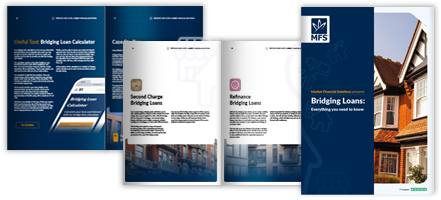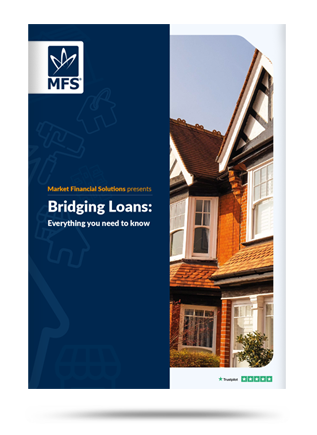Disclaimer
Market Financial Solutions are a bridging loan and buy-to-let mortgage provider, not financial advisors. Therefore, Investors are encouraged to seek professional advice. The information in this content is correct at time of writing.

When brokers come to us looking for support for their clients, they often enquire about our specialist options and if a bridging loan deposit is required.
There are multiple elements to this question however, as there are differing meanings of the word ‘deposit’, which we will break down as part of this blog. Firstly, we will look at Bridging more generally.
What is a bridging loan and what are they used for?
A bridging loan is a form of alternative finance that provides property investors with fast and flexible capital for their residential and commercial investments. These short-term loans help bridge the gap between payments.
Usually, these loans are secured against a property (or multiple properties), but other assets can sometimes be used. It may be possible to secure a bridging loan against artwork, or business machinery, for example. Although, this is usually called ‘Asset Finance’. At Market Financial Solutions, we only secure loans against property.
Often, bridging loans are used to secure a new home if the borrower is caught in a property chain. The new property would be purchased using the bridging loan, then the loan would be repaid once the existing property is sold, or long-term financial solutions are secured.
How does a bridging loan deposit work?
A deposit, in its classic sense, is usually a payment used to secure a property, or cover the first repayment instalment. This is a pledge made to pay the remaining balance, or go through with the commitment at a later date.
In this way, bridging loan deposits are usually known as, or referred to as, a commitment fee. A commitment fee is taken from the client to secure the agreed loan terms, such as interest rates, while legal documents are being drawn up.
The commitment fee represents a promise made between a client and a lender that the deal will go ahead. At Market Financial Solutions, we refund our commitment fees once loan funds are drawn down.
The other deposit that borrowers will have to pay are the funds used to secure a property – which we will refer to as a ‘property deposit’. The property deposit paid will depend on the value of the property, and the maximum ‘LTV’ a lender will loan against a property. For example, we will fund up to 75% LTV, meaning a borrower needs to pay 25% of the property’s value as a deposit.
What is LTV?
So, what does LTV mean?
In short, an loan-to-value (LTV) ratio is an assessment tool (or calculation) used to measure how much money is being borrowed compared to the value of a property. Lenders use LTV ratios to determine how much risk is involved in the issuing of a loan. Generally, the higher an LTV, the riskier it is for a lender.
As an LTV rises, so too will repayment costs, as more interest is added onto the loan. Generally, anything above 80% is considered a high LTV, while lower LTVs, those around the 60% mark, should offer reduced rates to borrowers.
As such, brokers will want to focus on what their clients’ property’s LTV is, and whether they can bring it down. Typically, brokers can bring down their clients’ LTV by asking them to pay a higher property deposit. Indeed, the higher the property deposit, the lower the amount that needs to be borrowed.
Let’s illustrate how that works: if a borrower has a deposit of £20,000 for a property worth £200,000, they’ll receive a bridging loan worth £180,000 to cover the rest. The deposit, therefore, covers 10% of the loan, so the LTV for the deal would be 90%.
What is the difference between regulated and unregulated LTV?
There are two types of bridging loans that brokers should be aware of: regulated and unregulated. A regulated loan can be defined as a loan that is issued under the regulations of the Financial Conduct Authority (FCA).
These are usually used for residential property purchases and are subject to stricter criteria and regulations than unregulated bridging loans. Unregulated bridging loans, therefore, may offer less stringent options for brokers and their borrowers.
When it comes to LTV and deposits, the main difference between regulated and unregulated loans is that, for regulated loans, the maximum LTV is 75%. Meanwhile, the maximum LTV for an unregulated loan can be up to 80% or higher. Of course, each lender’s own policies and processes will have an impact on what’s offered.
Source: Octagon

How much deposit do borrowers need for a 100% LTV bridging loan?
It is possible to provide a borrower with a 100% LTV bridging loan (i.e. where a borrower doesn’t need to pay a property deposit), but it is a rare occurrence. The lenders that do provide these kinds of loans usually need security in the form of another asset.
What deposit do you need to get a loan from Market Financial Solutions?
At Market Financial Solutions, our maximum loan-to-value (LTV) is 75%, meaning that the other 25% of a property’s value would need to be covered by the borrower with a property deposit.
Which securities do Market Financial Solutions accept, and what do other bridging lenders accept?
At Market Financial Solutions, we only accept property/properties as a security, but some lenders may accept other forms of security for their bridging loans. This could include commercial equipment, luxury cars, jewellery, artwork and more.
What paperwork do you need for a deposit?
There are some documents that lenders will need to see before they accept a deposit from a borrower. These may include:
- Proof of identity: The lender will often ask to see a borrower’s passport or driving license to confirm that they are who they say they are.
- Proof of income: Sometimes, the borrower will need to prove that they earn what they say they do. This can be determined by payslips or tax returns and proves that the borrower is borrowing within their means.
- Proof of savings: Similarly, lenders will ask to see evidence of a borrower’s savings. This is normally done via bank statements.
- Proof of assets: If a borrower is using an asset as their security, lenders will ask to see proof of ownership,
- Proof of deposit source: The lender may also require evidence of where the deposit funds are coming from, such as bank statements or a letter from a solicitor or accountant.
The specific paperwork required may vary between providers. So, it’s important to check with the lender to determine exactly what documentation is needed for a bridging loan deposit.
Why choose Market Financial Solutions as a lender?
Market Financial Solutions is a well-established specialist lender, with a 16-year track record in providing quality bridging loans. We have highly experienced underwriting staff who are specialists in complex circumstances, meaning we can react quickly and efficiently to any potential issues.
To help borrowers in special or complex circumstances, we do not adhere to tick-box criteria. Instead, we take the applicant and the property into consideration, assessing everything by their own individual merits. Meaning, we can provide finance for those with adverse credit, CCJs, complex company structures or undervalued properties.
Borrowers could see funds in their account in as little as three days, and we present all our charges upfront. You’ll be able to move forward confidently, knowing there are no hidden fees.
Find out more about Market Financial Solutions.
The Complete Guide to
Bridging Loans
Everything you need to know
- Different bridging types
- Useful tools
- Apply them in real life
- Market insights & more





